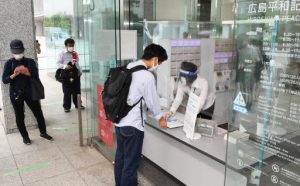75 years after the atomic bombing, Peace Memorial Museum reopens to communicate its message
Jun. 2, 2020
Prospects unclear, however, for survivors to share their A-bombing experiences
On June 1, the Hiroshima Peace Memorial Museum reopened following a three-month hiatus, resulting in visits from people within the prefecture and tourists from other parts of Japan and throughout the world. Compared to fiscal 2019, a year during which the largest number of people visited the museum in its history, the number of visitors on the day of the reopen was limited. Still, the museum reopened to convey the reality of what happened 75 years ago. With unclear prospects for the restart of the program in which A-bomb survivors relate to the public their experiences of the bombings, the survivors strongly hold onto their hope that the world will return to normal as soon as possible.
At 8:00 a.m. on June 1, several people waited in line in front of the museum’s east building entrance. Koji Kawamoto, 18, from Iwakuni, Yamaguchi Prefecture, will go on to an American college this fall. “I wanted to learn what happened in Hiroshima before I begin studying in the United States,” he said. He was the first to get into the museum after receiving a numbered ticket from a staff member standing behind protective plastic sheeting.
Jan Niklas Schunke, 20, who is from Germany and has been traveling in Japan since last summer, timed his schedule for visiting Hiroshima to coincide with the museum’s reopen. He said he definitely wanted to visit the facility because it conveys information about an important event in human history. After gazing intently at the exhibits, he said he came to fully understand the fearful nature of radiation, which has tormented victims for so long.
Junko Joyama, 66, a housewife living in Saeki Ward, said, “I have always wanted to come here. Measures have been taken to prevent spread of the virus, and the museum is uncrowded, so I took my time on my tour.” Kaito Ogasawara, 21, who lives in the city of Kure and is a senior at the Prefectural University of Hiroshima, hopes to produce a video based on the theme of the atomic bombing. “I hope to get it into shape by summer,” he said while continuing his careful observation of the exhibits.
Despite the fact that in March this year, the last month of Japan’s fiscal 2019, the museum temporarily closed, the number of visitors to the museum during fiscal 2019 reached 1,758,746, the highest number ever. In preparation for the museum’s reopen, the facility updated some of the materials on display and began exhibiting new materials obtained in recent years. The museum is once again upholding its function of conveying the reality of the atomic bombing through its exhibits.
On the other hand, because of the risk of coronavirus infection, the prospects for elderly survivors to restart conveying their A-bombing experiences to visitors are unclear. “All the sessions for sharing survivors’ experiences planned for May, a period during which many students typically visit on school trips, were cancelled,” said Toshiyuki Mimaki, 78, acting chair of the Hiroshima Prefectural Confederation of A-bomb Sufferers Organizations (chair: Sunao Tsuboi). “I hope we can return to normal as soon as possible, to ensure we are able to share our stories about the horrors of nuclear weapons,” he added.
The Hiroshima National Peace Memorial Hall for the Atomic Bomb Victims, also situated in Peace Memorial Park, reopened on the same date, June 1. Masayuki Kubo, director of the hall, said, “With the spread of the coronavirus, many people once more recognize the preciousness of life. I hope they also realize anew the significance of lives lost in the atomic bombings.”
(Originally published on June 2, 2020)








